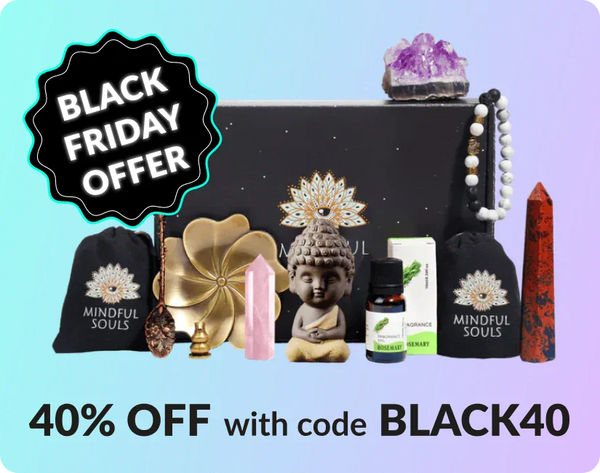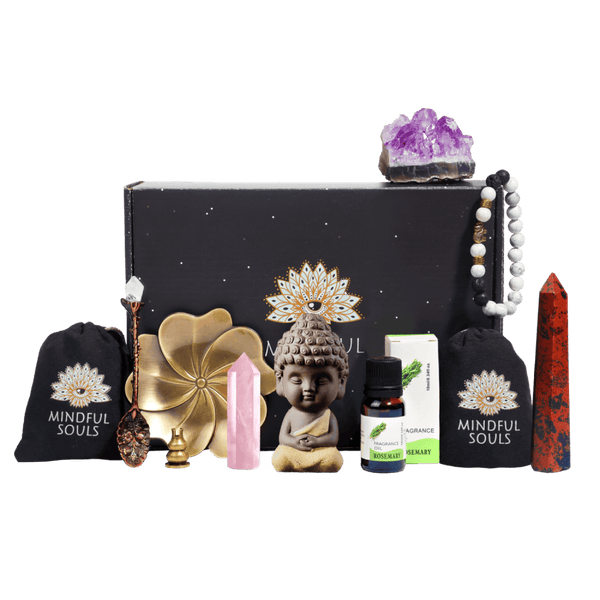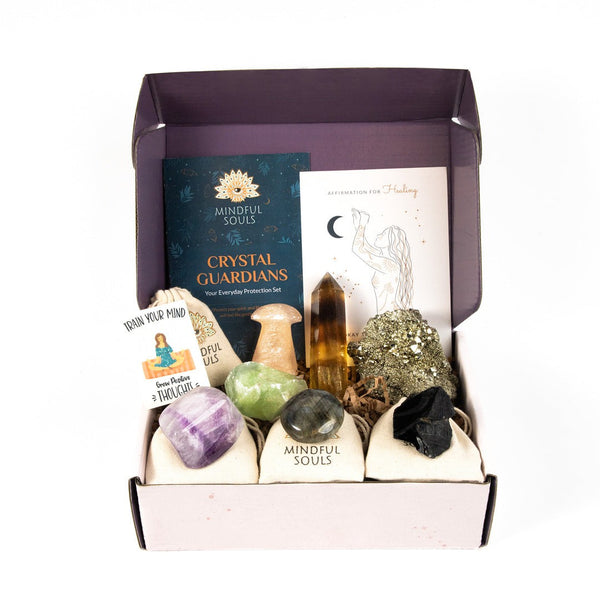A Beginner-Friendly Guide to Your Energy Centers
You’ve probably heard people talk about “blocked Chakras” or seen colorful chakra charts floating around Instagram. Maybe you’ve even wondered if you need a week-long yoga retreat just to understand them. Don’t worry, you don’t!
Chakras are far less mystical (and far more practical) than they’re often made out to be. At their heart, they’re a symbolic map of your inner world: seven energy centers that reflect different parts of your life, from feeling safe and grounded to speaking your truth or trusting your intuition.
In this guide, we’ll explore where chakras come from, what each one represents, and, most importantly, how you can actually work with them in daily life. Expect a mix of history, clear explanations, and down-to-earth practices you can try right away.
A Brief Origin Story
The chakra system comes from the ancient spiritual traditions of India, particularly yoga, Ayurveda, and Tantra. The Sanskrit word Chakra means “wheel” or “disk,” symbolizing a spinning center of energy.
Chakras are first mentioned in the Vedas, sacred texts written more than 2,000 years ago. Later, yogic and Tantric teachings expanded on the concept, describing chakras as points along the subtle body: an energy body that exists alongside the physical one. In these traditions, energy (called prana, or life force) flows through channels known as nadis, and the chakras are like hubs where this energy gathers.
Originally, different texts describe different numbers of chakras, not always seven. Some mention four, some six, others many more. The seven-chakra system most of us know today comes from later Tantric and yogic traditions, and it became the most widely used because it’s easy to map and remember.
Fast-forward to the 20th century: Western authors and teachers, fascinated by yoga and Eastern spirituality, began writing about chakras. This spread the concept worldwide, but also simplified it, sometimes losing depth in the process. That’s why today you’ll find everything from scholarly discussions of chakras in Sanskrit texts to Instagram posts telling you which smoothie to drink for your Sacral Chakra.
Both extremes miss the point. Chakras aren’t just historical artifacts or wellness clichés. They’re living symbols, tools for self-awareness and growth that can still be relevant, no matter your beliefs.

So, What Are Chakras?
At their simplest, chakras are described as energy centers along the spine, starting at the base and rising up to the crown of the head. Each Chakra is linked to a part of the body, a color, and specific emotional or spiritual themes.
But let’s be clear: you won’t find chakras under a microscope. They’re not physical organs. They belong to the subtle body, a concept in yoga and Ayurveda that refers to the energetic layer of our being. You might think of it as the bridge between body and mind.
Still, the effects are tangible. When energy flows freely through the chakras, you feel balanced: physically healthy, emotionally steady, spiritually open. When it’s blocked or excessive, you feel it as stress, illness, or emotional turbulence.
In short, chakras help us notice ourselves more clearly, and they point us toward practices that bring us back into harmony.

The Seven Chakras: Meanings, Qualities, and How They Affect You
Before we look at each energy center, it helps to understand that chakras work as a system. The lower chakras connect you with survival, creativity, and personal power. The Heart Chakra bridges body and spirit, self and others. The higher chakras connect you with intuition and meaning. Together, they form a holistic map of human experience.
Now that you have the basics, let’s dive into each chakra in detail.
Root Chakra – Your Foundation
Located at the base of the spine, the Root Chakra is the energy center that grounds you to life itself. It represents your most basic needs: food, water, shelter, and safety, as well as your deepest emotional needs. When this Chakra is weak, it can leave you feeling insecure and restless. When it is strong, you feel steady, safe, and at home in your own skin.
Muladhara (Root Chakra)
Location: Base of the spine
Color: Red, black, brown
Qualities: Grounding, stability, physical health
Element: Earth
Supportive Stones: Red Jasper, Black Tourmaline, Smoky Quartz
Affirmation: I am safe and grounded. My body is my home and shelter.
Sacral Chakra – The Creative Spark
Just below the navel lies the Sacral Chakra, the seat of creativity, sensuality, and emotional flow. It fuels your passion for art, pleasure, and relationships. Out of balance, life feels flat or chaotic. In harmony, it brings joy, inspiration, and fluid connection with others.
Svadhisthana (Sacral Chakra)
Location: Lower abdomen
Color: Orange
Qualities: Creativity, emotions, pleasure
Element: Water
Supportive Stones: Carnelian, Orange Calcite, Moonstone
Affirmation: I embrace creativity and allow myself to feel joy.
Solar Plexus Chakra – Your Inner Fire
Above the navel, the Solar Plexus Chakra glows like a personal sun. It governs willpower, motivation, and confidence. When weak, it feels like self-doubt or procrastination. When strong, it fuels your ability to take action and shine authentically.
Manipura (Solar Plexus Chakra)
Location: Upper abdomen
Color: Yellow
Qualities: Confidence, motivation, personal power
Element: Fire
Supportive Stones: Citrine, Tiger’s Eye, Amber
Affirmation: I am strong, capable, and radiant.
Heart Chakra – The Center of Love
At the center of the chest, the Heart Chakra is the bridge between body and spirit, self and others. It is where compassion, forgiveness, and unconditional love live. Closed, it feels heavy or resentful. Open, it flows with kindness and connection.
Anahata (Heart Chakra)
Location: Center of the chest
Color: Green
Qualities: Love, compassion, balance
Element: Air
Supportive Stones: Rose Quartz, Green Aventurine, Jade
Affirmation: I give and receive love freely and openly.
Throat Chakra – The Voice of Truth
The Throat Chakra is your voice. It governs communication, expression, and authenticity. When blocked, you might hold back words or struggle to listen. In balance, it gives you clarity and the courage to speak your truth.
Vishuddha (Throat Chakra)
Location: Throat
Color: Blue
Qualities: Communication, self-expression, truth
Element: Sound
Supportive Stones: Lapis Lazuli, Aquamarine, Blue Lace Agate
Affirmation: My voice is clear, strong, and true.
Third Eye Chakra – The Inner Guide
Between the eyebrows lies the Third Eye Chakra, home of intuition and inner wisdom. When clouded, you may feel indecisive or disconnected from your inner voice. When open, it sharpens perception, insight, and clarity.
Ajna (Third Eye Chakra)
Location: Between the eyebrows
Color: Indigo, violet
Qualities: Intuition, clarity, vision
Element: Light
Supportive Stones: Amethyst, Sodalite, Fluorite
Affirmation: I trust my inner wisdom and intuition.
Crown Chakra – The Connection Beyond
At the top of the head, the Crown Chakra is your connection to spirit, meaning, and the greater whole. Closed, it feels like disconnection or cynicism. Open, it brings peace, clarity, and a sense of unity with life itself.
Sahasrara (Crown Chakra)Location: Crown of the head
Color: White
Qualities: Spirituality, unity, higher consciousness
Element: Spirit
Supportive Stones: Clear Quartz, Selenite, Amethyst
Affirmation: I am connected to something greater than myself.

How to Do a Simple Daily Chakra Check-In
By now, you know what each chakra represents and how it influences your life. But here’s the next step: how do you figure out which one needs your attention right now? With seven different chakras, it can feel overwhelming to know where to begin.
The good news is, you don’t have to guess. A quick self-scan can show you exactly where your energy is calling for support.
This practice takes only five minutes and can be done anywhere: before bed, first thing in the morning, or whenever you feel off balance.
Here’s how to do it:
1. Sit comfortably, close your eyes, and take three deep breaths. Let your body soften with each exhale.
2. Imagine a line of light running up your spine, starting at the Root and rising all the way to the Crown.
3. Slowly bring your awareness to each chakra, one at a time. As you pause at each center, ask yourself: does it feel open, heavy, tight, or neutral?
4. When you notice a spot that feels blocked or tense, gently linger there. You don’t need to “fix” it, just observe with kindness.
5. Choose one way to support that chakra: repeat an affirmation, place a crystal over the area, visualize its color, or simply breathe deeply into that space.
With practice, this check-in becomes second nature. You’ll start to notice patterns:your throat may tighten before a presentation, or your heart may feel heavy after conflict. Instead of ignoring those signals, you’ll know where to focus your energy.
How to Balance Your Chakras
Once you’ve identified which chakra needs your attention through the daily check-in, the next step is knowing how to bring it back into harmony. Balancing your chakras is not about chasing a perfect state of alignment. Energy naturally flows and shifts throughout life, and imbalances are simply signals that something needs care. The goal is to restore harmony with small, steady practices that help your body, mind, and spirit reconnect.
Different tools can be used, such as yoga, meditation, sound, crystals, herbs, and even the simple act of paying attention to yourself. Below, we’ll explore each Chakra in turn and how you can bring it back into balance.
How to Balance the Root Chakra for Stability
To bring balance to your Root Chakra, focus on grounding practices that reconnect you with stability. Walking barefoot on natural ground, gardening, or cooking nourishing meals are simple ways to calm restlessness and remind your body it is safe. Yoga postures like Mountain or Tree strengthen this sense of steadiness.
In meditation, visualize red light at the base of your spine, glowing stronger with each breath. Pairing this with the affirmation “I am safe and supported” can be deeply restorative. Earthy tools like Red Jasper or Hematite crystals, or a cup of Dandelion root tea, act as anchors for your practice.
Mini Ritual: Sit comfortably with both feet flat on the ground. Hold a grounding crystal in your hand, close your eyes, and take ten slow breaths. Imagine roots growing from your feet deep into the earth, carrying away tension and returning calm.
How to Heal the Sacral Chakra for Emotional Flow
The Sacral Chakra thrives on creativity and flow. To restore balance, move your body freely—dance in your living room, practice hip-opening yoga poses, or enjoy time near water. Play and pleasure are powerful healers here.
In meditation, picture a warm orange glow in your lower abdomen, pulsing like gentle waves. Repeat the affirmation “I embrace creativity and joy.” Support with Carnelian or Moonstone crystals, or sip Hibiscus tea to invite openness.
Mini Ritual: Light a candle, put on your favorite music, and let your body move for a few minutes without choreography or judgment. Focus on how the movement feels, not how it looks.
How to Strengthen the Solar Plexus Chakra for Personal Power
This energy center is fueled by confidence and personal power. Strengthen it with core-activating yoga poses like Boat or Plank, or spend time in sunlight to recharge your inner fire.
During meditation, visualize a golden sun shining above your navel, spreading warmth through your whole body. Affirm: “I am strong, capable, and radiant.” Citrine or Tiger’s Eye crystals and warming herbs like Ginger or Turmeric enhance this fiery energy.
Mini Ritual: Place your hand on your belly, sit upright, and take a few strong breaths, feeling your abdomen rise and fall. As you exhale, imagine releasing self-doubt. As you inhale, imagine drawing in courage and light.
How to Open the Heart Chakra for Love
To balance the Heart Chakra, practice gratitude and acts of kindness. Writing down what you appreciate or spending time with loved ones softens emotional walls. Heart-opening yoga poses like Camel or Bridge create spaciousness in the chest.
In meditation, imagine green light glowing from your chest, spreading warmth through your arms and out into the world. Affirm: “I give and receive love freely.” Rose Quartz or Jade crystals, along with herbal allies like Rose or Hawthorn, support this center.
Mini Ritual: Hold a crystal or simply place your hand over your heart. Close your eyes and name three things you are grateful for today, breathing deeply with each one.
How to Balance the Throat Chakra for Clear Communication
The Throat Chakra finds balance through expression. Sing, hum, or journal to release blocked emotions. Yoga poses like Fish or gentle neck stretches help open this area physically.
Meditate by picturing a blue light spinning at your throat. Repeat: “My voice is clear and true.” Lapis Lazuli or Aquamarine crystals, and soothing teas like Peppermint, bring ease to communication.
Mini Ritual: Pour yourself a warm cup of tea, and while sipping, speak an affirmation out loud three times. Feel the vibration of your voice as a cleansing and empowering force.
How to Awaken the Third Eye Chakra for Inner Wisdom
The Third Eye Chakra thrives on stillness and reflection. Spend time in meditation or keep a dream journal to strengthen intuition. Child’s Pose or simple seated meditation helps quiet the mind.
Visualize an indigo light glowing between your eyebrows. Affirm: “I trust my inner wisdom.” Amethyst or Sodalite crystals and calming herbs like Lavender or Rosemary are excellent allies.
Mini Ritual: Before bed, place an Amethyst crystal or simply your hand on your forehead. Take three slow breaths and ask yourself: What is my intuition telling me right now? Write down any impressions.
How to Align the Crown Chakra for Spiritual Connection
The Crown Chakra balances through connection with stillness and spirit. Spend time in meditation, silence, or stargazing to feel part of the greater whole. Yoga poses like Savasana encourage surrender and openness.
Visualize violet or white light streaming into the top of your head, expanding into spacious awareness. Affirm: “I am connected to something greater than myself.” Clear Quartz or Selenite crystals, and scents like Frankincense or Sandalwood, uplift this practice.
Mini Ritual: Sit quietly under the sky, day or night. With each breath, imagine your crown opening gently to receive universal light. Stay with this for a few minutes, feeling a sense of calm and unity.
Moving Beyond the Basics
Now that you’ve learned how to unlock and balance your chakras, you might be wondering what comes next. The truth is, there’s no single “right” way to work with your energy. Your practice can be as simple or elaborate as you want it to be.
What matters most is consistency and intention. A few minutes of daily practice often has more impact than a long ritual done only once in a while. Over time, you’ll develop a personal rhythm and begin to notice which practices resonate most with your body and spirit.
Final Thoughts
Chakras may sound mystical, but at their heart, they’re simply a framework: a colorful, symbolic way to check in with yourself. Each chakra shines a light on a different part of life: feeling safe, enjoying creativity, stepping into confidence, opening your heart, speaking your truth, trusting your intuition, and connecting to meaning.
You don’t have to “believe” in chakras for them to be useful. You can see them as metaphors, as tools for reflection, or as genuine energy centers. Either way, they invite you to pause, notice, and care for yourself more fully.
So, take a moment: which chakra feels like it’s calling for attention today? Maybe your Root is craving stability, your Throat is longing to speak, or your Heart just wants more kindness.
Wherever you begin, remember: the journey itself is the balance.

What to know more How chakra can be unblocked - Here's A Complete Guide to unblock your chakras.



